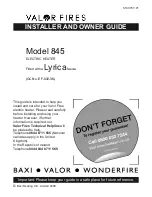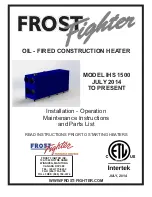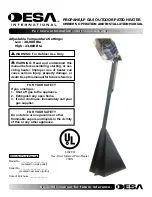
H I G H P R E S S U R E P O R T A B L E F O R C E D A I R H E A T E R S E R V I C E M A N U A L
5
Fuel Selection
One of the most critical specifications for
trouble-free operation is the use of a clean,
acceptable fuel. Listed below are guidelines
and comments concerning operation of heat-
ers with different fuels.
Recommended
Fuels
Comments
Kerosene
Best overall results. Mini-
Fuel Oil No. 1
mum odor and minimum
Jet “A”
maintenance. No additives
necessary for cold weather
operation.
Alternate Fuels Comments
Fuel Oil No. 2
Noticeable increase in
Diesel No. 1
odor. Requires frequent
Diesel No. 2
maintenance of fuel filter,
nozzle and spark plug.
Cannot be used at tem-
peratures below +20
°
F.
Electrical
Connect heater to a standard electrical outlet
(120V/60Hz) to operate. For safety, all heat-
ers have a three-prong, grounded power
cord. Plug power cord of heater into three-
prong, grounded extension cord. Extension
cord must be at least six feet long. Make sure
you use extension cord large enough to carry
the voltage the heater requires. Use the
following chart to determine the proper size
extension cord for heater.
Length of Cord
Wire Size (AWG)
100 ft.
No. 14
200 ft.
No. 12
300 ft.
No. 10
400 ft.
No. 8
500 ft.
No. 6
3
S E C T I O N
Ventilation
Only use heater in well-ventilated areas. The
following chart shows the minimum fresh,
outside air opening needed for proper venti-
lation.
Heater Size
Square Foot
(BTU/Hr)
Opening
250,000
7.5
300,000
9.0
350,000
10.5
600,000
18.0
The above chart is based on ventilation re-
quirements of at least a three (3) square foot
fresh, outside air opening for each 100,000
BTU/Hr of rating. Provide extra fresh air if
using more heaters. If possible, provide cross-
ventilation for better air movement. This
heater produces carbon monoxide, which is
listed by the State of California as a repro-
ductive toxin under Proposition 65.
Heater Sizing
Use heater which is properly sized for the
area to be heated. Listed below is a simple
formula that allows you to determine heater
BTU/Hr size requirements.
Cubic Feet of Area x .133 x Desired
Temperature Rise
°
F = BTU size
Example
Area: 100' x 100' x 8' = 80,000 Cubic Feet
Desired Temperature Rise: 30
°
F
80,000 (Cubic Feet)
x .133 (Factor)
10,640
x 30 (Temperature Rise)
319,200 (BTUs/Hr Needed)
Answer:
Use a 350,000 BTU/Hr
heater for this heating example.
GENERAL SPECIFICATIONS AND APPLICATIONS INFORMATION






































